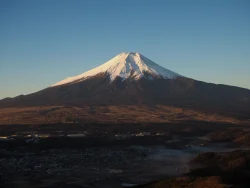
May 5, 2011
Mission Tohoku Photo Essays
Three volunteers document their journeys to the tsunami zone
By Metropolis
Originally published on metropolis.co.jp on May 2011
For more on this subject see Global Village issue 893
From death to hope
 Text by Luciano Uchizono. Photos by AX Hope.
Text by Luciano Uchizono. Photos by AX Hope.
Red Cross Disaster Rescue Camp. Ishinomaki Hospital, March 13, 2011. Three days after the disaster, the Red Cross had set up a rescue camp at Ishinomaki Hospital where thousands of injured people were being treated. It was a very intense experience watching helicopters, ambulances and army vehicles constantly arriving with injured people. The hospital was so full that people were being treated in the lobby and corridors. The hospital was divided into three areas: Red: intensive care and seriously injured; Yellow: injured; Green: not seriously injured, mostly needing medicine.
 Finding a body. Ishinomaki, March 14, 2011. We found the body of a 60-year-old man in the water on the way to Ishinomaki and contacted the army to recover it. It was really sad to see the neighbors identify him, and emotional to receive thanks from the army.
Finding a body. Ishinomaki, March 14, 2011. We found the body of a 60-year-old man in the water on the way to Ishinomaki and contacted the army to recover it. It was really sad to see the neighbors identify him, and emotional to receive thanks from the army.
 Stranded dog. Ishinomaki, March 14, 2011.
Stranded dog. Ishinomaki, March 14, 2011.
 Luciano Uchizono and evacuee Mitsuki Akiyama. Ishinomaki Kama School ‘shelter,’ March 14, 2011. This is my new friend Mitsuki Akiyama. We met on Monday, three days after the disaster and since then have kept in touch. His family lost its house and has been at Ishinomaki Kama School for over a month. The first hot meal they had was seven days after the quake and I was there to witness it. We are providing them with as much as we can but they still have no power, meaning it is pitch black and cold at night. He calls me often and always looks forward to our visit. This time I let him drive the truck—boys never forget their first drive! He is a lovely boy and I made him responsible for looking after his family and he is doing a great job. He and his friends say they love games so if anyone has any portable games I am sure this would make them very happy.
Luciano Uchizono and evacuee Mitsuki Akiyama. Ishinomaki Kama School ‘shelter,’ March 14, 2011. This is my new friend Mitsuki Akiyama. We met on Monday, three days after the disaster and since then have kept in touch. His family lost its house and has been at Ishinomaki Kama School for over a month. The first hot meal they had was seven days after the quake and I was there to witness it. We are providing them with as much as we can but they still have no power, meaning it is pitch black and cold at night. He calls me often and always looks forward to our visit. This time I let him drive the truck—boys never forget their first drive! He is a lovely boy and I made him responsible for looking after his family and he is doing a great job. He and his friends say they love games so if anyone has any portable games I am sure this would make them very happy.
 Luciano Uchizono and soldier. Miyako City, March 17, 2011. The soldier beside me told me this village had around 1,000 people missing from its 1,500 population. Since the tsunami six days before over 500 soldiers were working non-stop under sever weather conditions here, and so far had saved 10 people, most of them seriously injured but alive. He told me with tears in his eyes, “Realistically the chances of finding someone alive at this point are low. But if we can find even one person it will have been worth the effort.” These words will stay with me for the rest of my life.
Luciano Uchizono and soldier. Miyako City, March 17, 2011. The soldier beside me told me this village had around 1,000 people missing from its 1,500 population. Since the tsunami six days before over 500 soldiers were working non-stop under sever weather conditions here, and so far had saved 10 people, most of them seriously injured but alive. He told me with tears in his eyes, “Realistically the chances of finding someone alive at this point are low. But if we can find even one person it will have been worth the effort.” These words will stay with me for the rest of my life.
 Luciano Uchizono and Miura family. Ishinomaki, March 23, 2011. We stocked our truck full of supplies here and saw this family trying to retrieve their belongings from their building. They lived in a seafront building on the 3rd floor and fled the tsunami to the 4th floor. Thankfully the concrete structure withstood waves that rose up to the 3rd floor with pieces of trees, boats and debris. They told me about the fear of standing there during the tsunami, not knowing if the building would collapse at any second. Some neighbors didn’t have time to escape. They said they still have nightmares about it.
Luciano Uchizono and Miura family. Ishinomaki, March 23, 2011. We stocked our truck full of supplies here and saw this family trying to retrieve their belongings from their building. They lived in a seafront building on the 3rd floor and fled the tsunami to the 4th floor. Thankfully the concrete structure withstood waves that rose up to the 3rd floor with pieces of trees, boats and debris. They told me about the fear of standing there during the tsunami, not knowing if the building would collapse at any second. Some neighbors didn’t have time to escape. They said they still have nightmares about it.
 Minami Kesennuma School, March 23, 2011. This school was hit by a large tsunami and some students and parents remain missing. The headmaster lost his house and his mother. They had been planning a graduation, but due the disaster they were thinking to cancel it. But the headmaster wanted so much to deliver the diplomas to all students. So he went back to the school after the water level dropped, and found the diplomas all wet. He gathered the teachers, and they dried them with a hair dryer and ironed the diplomas one by one to make sure the students got theirs. I was there to witness this emotional graduation where the diplomas were a bit damaged but proudly distributed to all students.
Minami Kesennuma School, March 23, 2011. This school was hit by a large tsunami and some students and parents remain missing. The headmaster lost his house and his mother. They had been planning a graduation, but due the disaster they were thinking to cancel it. But the headmaster wanted so much to deliver the diplomas to all students. So he went back to the school after the water level dropped, and found the diplomas all wet. He gathered the teachers, and they dried them with a hair dryer and ironed the diplomas one by one to make sure the students got theirs. I was there to witness this emotional graduation where the diplomas were a bit damaged but proudly distributed to all students.
 Terutaka Yamaji and 13-year-old Kazuma. Ishinomaki, April 3, 2011. I had met two teenagers with their parents walking through the rubble in Ishinomaki on March 18 and approached them to see if they needed help. They told me that their family was safe as they had climbed a nearby hill, but that they had lost everything and were hoping to find some of their belongings. I asked the boy what he needed the most, and about his hopes for the future. He looked at me and said: “I want everything back to normal soon so I can play soccer.” I remembered seeing a soccer ball in the rubble a couple meters’ away, so I ran to get the ball and kicked to him. He proudly showed us some ‘Brazilian soccer moves.’ The boy and I exchanged contacts and shook hands. I promised him we would be back with some soccer balls for him. On April 3 we returned and Terutaka Yamaji, president of Armani Exchange, joined our disaster relief team and donated soccer balls and T-shirts signed by famous soccer players to inspire this young boy to look to the future.
Terutaka Yamaji and 13-year-old Kazuma. Ishinomaki, April 3, 2011. I had met two teenagers with their parents walking through the rubble in Ishinomaki on March 18 and approached them to see if they needed help. They told me that their family was safe as they had climbed a nearby hill, but that they had lost everything and were hoping to find some of their belongings. I asked the boy what he needed the most, and about his hopes for the future. He looked at me and said: “I want everything back to normal soon so I can play soccer.” I remembered seeing a soccer ball in the rubble a couple meters’ away, so I ran to get the ball and kicked to him. He proudly showed us some ‘Brazilian soccer moves.’ The boy and I exchanged contacts and shook hands. I promised him we would be back with some soccer balls for him. On April 3 we returned and Terutaka Yamaji, president of Armani Exchange, joined our disaster relief team and donated soccer balls and T-shirts signed by famous soccer players to inspire this young boy to look to the future.
Next page: “Afshin’s Magic Carpet Ride”







